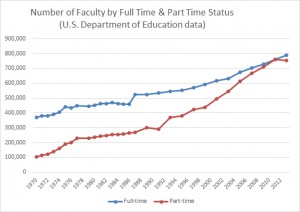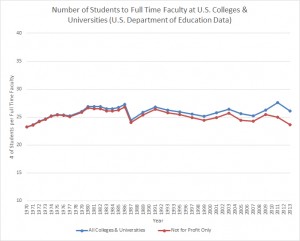The recent and ongoing debate about the state of the U.S. academic workforce is, unfortunately, dominated by a number of aggressively asserted myths that have little basis in empirical evidence. In previous posts, I have debunked a number of these recurring claims including the “myth of the minimum wage adjunct” and the “myth of the 76% adjunct majority.” Though a number of irritated parties continue to assert otherwise, the statistical evidence against each of these myths is pretty much overwhelming.
A new report by the Campaign for the Future of Higher Education brings to light a third common myth of this debate: the claim that full time faculty positions are being “adjunctified,” or phased out and replaced by inexpensive part time instructors. The CFHE report directly makes this claim in several places:
- “[R]ecent trends and newly-adopted practices in higher education actually decrease the possibilities for faculty to interact with students in the amounts and the ways that matter most.”
- “[W]hat is happening in our country…is a growing disinvestment in faculty.”
- “You see it on every campus…a decrease in full-time faculty, and an increase in the use of part-time faculty”
- “Administrators for decades have been replacing full-time, permanent (tenure track) faculty with part-time faculty on temporary contracts”
- “At public non-research institutions, part-time faculty (and graduate assistant) positions are not simply additional hires to deal with increased enrollments. They have replaced full-time positions.”
This same claim is similarly pervasive in media coverage of adjuncting, not to mention adjunct unionization advocacy. Yet like the other myths of adjuncting that I’ve examined in previous posts, this one is simply not true.
To the contrary, two trends are immediately evident in the empirical data from the U.S. Department of Education:
I. The total number of full time faculty positions is on the INCREASE:
The CFHE report asserts that full time faculty positions are being cut and replaced by adjuncts. As I showed in multiple previous posts, there is simply no truth to this claim. The total number of full time faculty positions has increased every single year since the mid 1980s, and has more than doubled from where it stood in 1970. It is true that adjunct positions have grown in number as well (fueled heavily by the rise of the for-profit college industry), yet in absolute numbers the oft-repeated claim about the decrease in full-time faculty has zero basis in reality:
II. The ratio of students to full time faculty has remained STABLE since at least 1970:
The CFHE report similarly claims that universities have turned to “adjunctification” as a means of dealing with increased student enrollments. The adjunct activists assert that, instead of hiring new full time faculty, U.S. higher ed has absorbed the influx of students by hiring more part timers. This claim is equally specious.
In reality, the ratio of students to full time faculty has remained remarkably stable since 1970. Both have grown at nearly identical rates, especially if you exclude the for-profit college industry. In 1970 the ration stood at 23.2 students per full time faculty. Today it stands at 26.08 students per full time faculty with for-profit colleges included, or 23.65 without. Allowing for normal fluctuations between 23 and 27, this ratio has remained almost perfectly constant between 1970 and the present day.
Stated differently, student enrollments in 2013 stood at 2.37 times their 1970 level including for-profit colleges, and 2.19 times their 1970 levels when we only look at traditional not-for-profit colleges and universities. By comparison, the number of full time faculty today is 2.14 times its 1970 level. Full time faculty growth has virtually matched the growth in students.
Why are Adjunct Positions Growing?
Of course, adjunct positions have in fact grown precipitously in number since 1970 as well. The key distinction here is that they are expanding in addition to the growth in full-time faculty, not as “replacements” for full-time positions as is commonly claimed. Adjunct growth may be traced to a couple of different sources:
- The for-profit college boom of roughly 1990 to 2011 dramatically accelerated the growth in part time positions (though this has also started to decline due to the post-2011 for-profit bubble burst)
- Hiring part-time faculty is an inexpensive way to increase the diversity and number of course offerings
- Hiring part-time faculty is an inexpensive way to further reduce the overall student-to-faculty ratio, which helps with university rankings and as a marketing point for attracting new students
Note that none of these factors decrease the number of full time positions, or “replace” full time faculty with adjuncts. In reality, adjunctification (outside of the for-profit realm) simply reflects an expansion of university offerings even as the full time faculty core continues to grow at a stable rate that is at parity with the growth of the student body and has been for the past 40 years.

